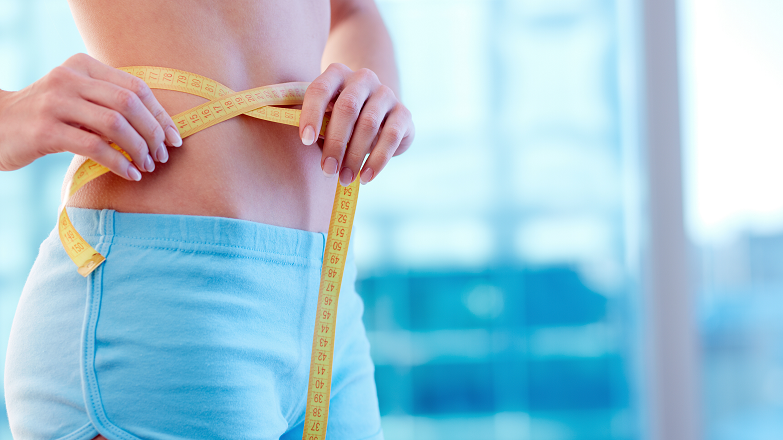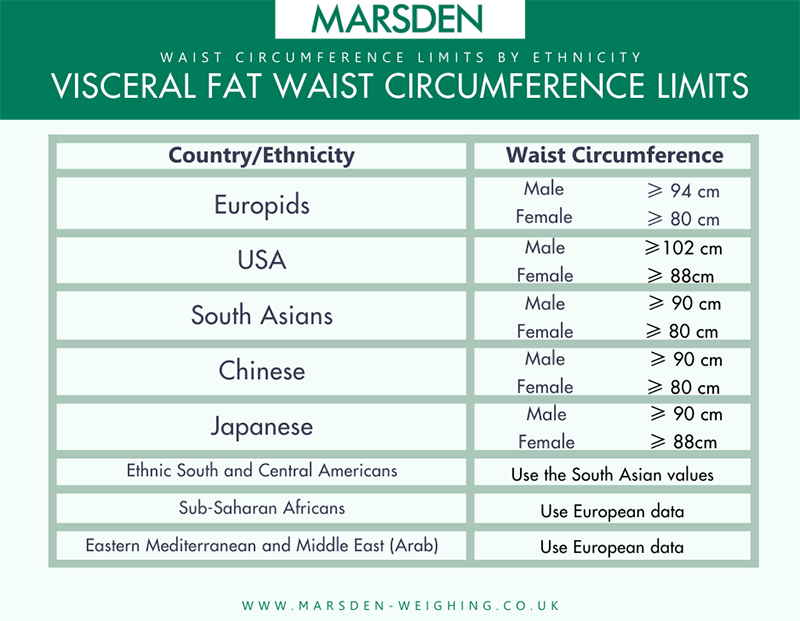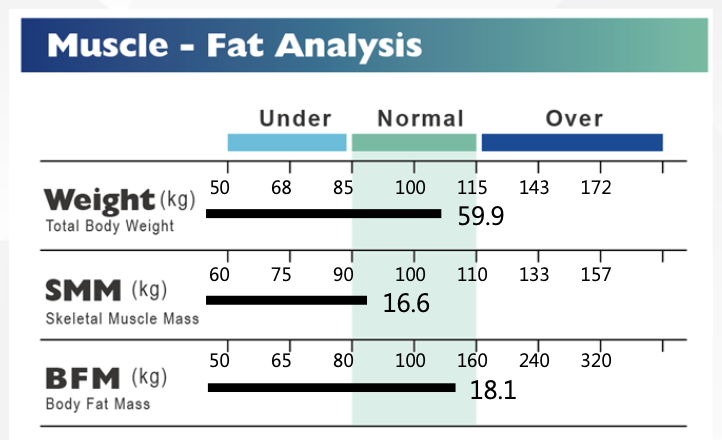What Is the Skinny Fat Body Type (and How to Fix It)?

It’s easy to assume that if your weight and your BMI are in a healthy range then you have nothing to worry about. However this is not always the case. A person can appear to be fit and healthy, but actually have dangerous levels of body fat internally.
So, what is the skinny fat body type?
What Does 'Skinny Fat' Mean?
The phrase ‘skinny fat’ or metabolically obese normal weight (MONW) is used to describe someone who appears to be lean, but actually has a high body fat percentage. If they were to calculate their body mass index (BMI) or even weigh themselves, they may appear to be healthy, but this can be deceiving.
Unlike body composition scales, BMI only takes height and weight into account. It doesn’t factor skeletal mass, muscle mass or body fat mass into the equation, which is why it’s not a reliable measurement.
Even WHO states that BMI should only be a rough guide, as it uses the same body fat percentage across all individuals. That means that, while subcutaneous fat is easy to see and understand, visceral fat can hide behind a healthy BMI.
But, What Is Visceral Fat?
Visceral fat is fat stored inside the abdominal cavity. This means that it can build up and wrap around your organs and arteries, without you even noticing.
Most of the time people aren’t even aware that they have a large amount of visceral fat, as you generally can’t see or feel it. In fact, some people refer to high levels of visceral fat as thin outside, fat inside (TOFI), which is likely where the phrase skinny fat came from.
The worst part is that visceral fat can actually be more damaging than subcutaneous fat, because of where it’s stored.

What Causes Someone to Become Skinny Fat?
As a society, we are putting too much weight on weight.
Body weight doesn’t actually tell us the whole story. Neither does BMI. But, because we live under the impression that being slim is the same as being healthy, most people assume that they’re one and the same.
This actually makes the situation worse. When we are under the illusion, we believe that when we are slim we can eat unhealthily and don’t need to exercise - a fast track path to becoming skinny fat.
Essentially, the skinny fat condition is developed by dieting badly and not exercising properly. Given that the amount of energy you burn is affected by the amount of muscle mass you have, as you lose muscle you will gradually burn less calories than before.
Office workers are also prime candidates for becoming skinny fat due to a sedentary work life and the difficulty of eating healthy in an office environment.
A person can also become skinny fat if they diet without carrying out strength training. While cardio is effective, by only doing cardio a process called atrophy can be triggered. This is when bodies require more energy than is available, so they break down muscles that aren’t being utilised to convert them into energy.
Make sure you’re supplementing your cardio with strength training to avoid this happening.
What can cause someone to become skinny fat?
- Doing excessive cardio while consuming negative calories.
- Not having enough muscle mass.
- Not doing enough strength training.
- Not eating enough protein.
- Being in a caloric deficit.
- Being stressed.
What Are the Dangers Involved With Being Skinny Fat?
Harvard Medical School plainly states that “visceral fat is more of a health concern than subcutaneous fat.” According to their article, visceral fat has been linked to:
- Increased risk of cardiovascular disease.
- Affected sensitivity to insulin, blood pressure, and blood clotting.
- High cholesterol
- Insulin resistance (heightening the risk of diabetes)
A study published in the Annals of Internal Medicine found that normal-weight people who carried excess weight around their midsections had the highest risk of dying early. Even when compared to people who had overweight or obese BMIs.
Visceral fat has also been strongly linked to metabolic disease.
How Can I Tell if I’m Skinny Fat?
There are several ways to measure your body fat percentage, some of which are more reliable or more convenient than others:
Waist Circumference
This is the cheapest and most convenient way to measure your body fat levels, although it’s not as reliable. All you need is a tape measure.
In order to measure your waist correctly, position the tape measure in the space between your lowest rib and hip bone. Wrap your tape snugly around your waist and then measure just after you breathe out.
If this is confusing, here is a useful video guide to show you how to measure your waist.
Generally, if you’re a female whose circumference is greater than or equal to 35 inches (88.9 cm), then there’s a chance you have excess fat. For males a waist circumference that is greater than or equal to 40 inches (101.6 cm) can also indicate excess fat.
The International Diabetes Federation lists waist circumference values by ethnicity. They can be viewed below:

The World Health Organisation (WHO), on the other hand, suggests using a waist to hip ratio to determine how much fat is stored on your waist, hips, and butt.

Waist to height ratio is another option. Take a piece of string and measure how tall you are. Then fold this string in half and wrap it around your waist. If it doesn’t stretch the entire way around then you’re likely at risk of being skinny fat.
As you can see from the various methods of carrying out this method, this isn’t as reliable as other options. There’s also a significant amount of user error involved. If you don’t position the tape measure correctly, read it wrong or incorrectly work out the ration, this can cause a false result.
Calipers
Skinfold Calipers, or calipers, are one of the most common methods for calculating your body’s total percent of body fat. They can be relatively cheap to buy and are easy to use.
Simply pinch the fold of your skin with the underlying layer of fat and place the jaws of the calipers around the bundle. Keep a firm hold on your skin with your fingers as you measure the fat percentage.
This should be measured in four different locations to get an accurate result:
- Back of the arm (triceps)
- Front of the arm (Biceps)
- Shoulder blade
- Waist
Then use a caliper chart to calculate your body fat.
However, as with waist circumference, there’s also a level of human error here. Incorrectly pinching the body fat (too hard, too soft) can result in false results. Plus calipers can only really measure your subcutaneous fat. Then prediction tables are used to guess at your visceral fat.
As you can probably tell, this is not very reliable unless carried out by trained professionals.
BIA Scales/Body Composition Scales
In our opinion, this is one of the best ways to calculate your body fat percentage. Body composition scales are more accessible than the following two factors, but more accurate than calipers and measuring your waist.
BIA scales use a safe, weak electric current, which travels around the body to calculate different values. Fat, muscle and water all have different levels of resistance. So BIA scales can work out the different quantities of each depending on the amount of resistance to the bioelectric current.
After getting your results, you can compare it to the recommended body fat ranges. Healthy Men should aim to have between 10-20% body fat, while healthy women should have a body fat percentage between 18-28%.

This image is taken from the result sheet of the Charder MA601. Ideally you want your Weight, Skeletal Muscle Mass and Body Fat Mass to either be in line with each other, or the SMM should exceed the other two values.
If you have a ‘C’ shaped result sheet, as shown above, this is worrying and can be a sign of a skinny fat body type. This can also indicate a sarcopenic obese body profile.
Most body compositions provide printed result sheets, so that you can compare your weightloss journey over time. They are also relatively easy to use. Take off your shoes and socks, input your height and age and it will show you your body composition results.
Many gyms, personal trainers and fitness groups offer access to a body composition scale, either for free or for a small cost. Alternatively some can be purchased for relatively cheap if you’d prefer to have one at home such as the MBF-6000 Body Composition Scale.
However there are other factors involved.
Buying a bathroom scale with body fat percentage included is not always a guarantee for an accurate result. Especially when choosing a low-priced version. The BBC One Show looked at the accuracy of bathroom scales measuring body fat and discovered that some were inaccurate by around 30%.
Unlike calipers and tape measures, however, there’s not a huge amount of human error involved in this option.
To ensure you’re getting accurate results, choose an accurate body composition scale, such as the Marsden MBF-6000 Body Composition Scale with Printer or the Charder MA601 Advanced Body Composition Analyser.
Underwater Weighing
Hydrostatic weighing is one of the most accurate ways to measure body fat. Lean tissue, such as muscle, is more dense than water, which means it sinks. Whereas fat is less dense and is therefore more buoyant and will float.
That means the weight of someone in water can vary substantially depending on their body composition.
However this is not a very accessible method. Sometimes universities allow the public to use their facilities, however this can be upwards of £40 a go. It also doesn’t identify the area of the body where the fat is built up.
DEXA
Dexa is considered the golden standard for body composition.
After lying on a table, a machine passes over your body and emits a x-ray beam that scans your body. Technicians then read the results to tell you your body composition breakdown.
This is incredibly accurate, but also, understandably, the hardest option to access. It can cost more than £100 for one measurement and is not widely available. Plus, you will be exposed to low levels of radiation.
What Steps Can I Take to Reduce Visceral Fat?
Simply put, you need to increase your muscle mass and reduce your fat mass.
Weight training is probably the easiest way to do this. Not only does this increase your Skeletal Muscle Mass, but it can also increase your Lean Body Mass. The more Lean Body Mass you have, the better your Basal Metabolic Rate (BMR), which means you burn more calories when you’re doing nothing.
Sounds great!
If your goal is weightloss, you may be disappointed, however. Muscle weighs more than fat so by building muscle and losing fat you may actually gain weight. But, you’ll look better.
There’s a number of everyday habits that you can practice to reduce visceral fat or avoid becoming skinny fat:
- Eat a Balanced Diet. Eating less sugar and more of the four major food groups will help you lose weight. Avoid processed food and focus on eating plenty of fruit and veg to improve your overall health.
- Don’t Forget Protein. Everyone talks about protein when it comes to building muscles and really it’s vital. It can protect your muscles and help build them, plus it fills you up so you don’t eat as often. Load up on eggs, nuts, fish and chicken to check this box.
- Don’t Discount Carbs. Carbs shouldn’t be off-limits, just choose the right ones. Instead of white bread and pasta, choose brown rice and corn; these are much better for your body.
- Increase your Fiber Consumption. The goal is to eat 30g of fiber every day to keep your energy up and make you full. This can come from fruit, vegetables, nuts or seeds.
- Get Moving! Starting a workout regime is hard, but after reading this article you’re probably motivated. Aim for 150 minutes of moderate exercise every week to start meeting your weightloss goals.
- Start Lifting. People with higher muscle mass have a lower risk of death and heart disease. Plus, as we stated above, you’ll burn even more calories while just sitting around, because of a higher Basal Metabolic Rate.
- Take a Break. Although we didn’t touch upon it much, stress can actually cause weight gain. Try relaxing with yoga, meditation or reading to get your stress levels down on an evening. That might even help you feel better the next day.
- Get Some Shut-eye. It’s recommended to have six to eight hours of sleep a night. If you don’t, you may not have the energy to complete the next day, which can lead to more snacking and skipping your workout! Not ideal if you want to lose weight.
- Stay Hydrated: Water is a great way to lose weight. It’s got 0 calories, it can fill you up and most people don’t drink enough so it’s a really easy solution. Get a big water bottle or a water tracking app and get drinking
Find Out More
Have you ever wanted just a body rating to know how your body is doing? Well there is one. The Health Score measurement takes into account all your other results to provide an overall health score.
While weight isn’t as important now, it can still be a good indicator of weight loss. But how often should you weigh yourself?
If you have a body composition scale, we've put together this complete guide of body composition scale measurements.
If you are looking to purchase a body composition scale, we have a range of high quality options on our website: Body composition scales